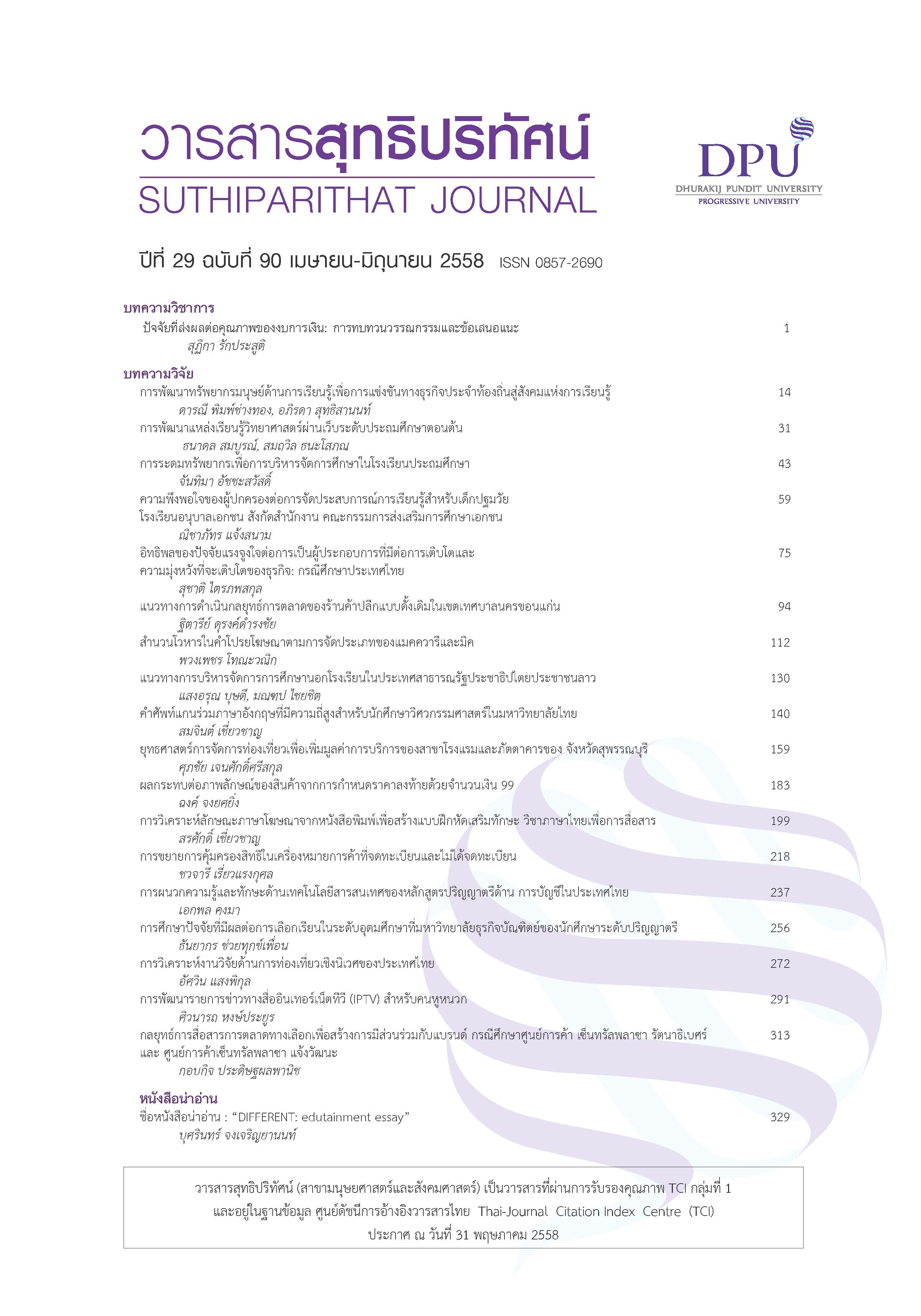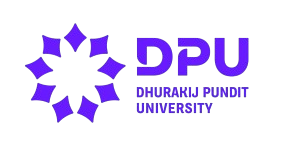ยุทธศาสตร์การจัดการท่องเที่ยวเพื่อเพิ่มมูลค่าการบริการของสาขาโรงแรมและภัตตาคารของจังหวัดสุพรรณบุรี
คำสำคัญ:
ยุทธศาสตร์การจัดการท่องเที่ยว, มูลค่าการบริการสาขาโรงแรมและภัตตาคารบทคัดย่อ
การศึกษายุทธศาสตร์การจัดการการการท่องเที่ยวเพื่อเพิ่มมูลค่าการบริการของสาขาโรงแรมและภัตตาคารของจังหวัดสุพรรณบุรี มีวัตถุประสงค์เพื่อ 1) ศึกษาการเพิ่มมูลค่า การบริการของสาขาโรงแรมและภัตตาคารของจังหวัดสุพรรณบุรี 2) ศึกษาประสิทธิผลการดำเนินงานยุทธศาสตร์การจัดการการท่องเที่ยว 3) ศึกษาความสัมพันธ์ระหว่างประสิทธิผลการดำเนินงานยุทธศาสตร์การจัดการการท่องเที่ยวกับการเพิ่มมูลค่าการบริการของสาขาโรงแรมและภัตตาคารของจังหวัดสุพรรณบุรี และ 4) เพื่อสร้างตัวแบบยุทธศาสตร์การจัดการการท่องเที่ยวเพื่อเพิ่มมูลค่าการบริการสาขาโรงแรมและภัตตาคารของจังหวัดสุพรรณบุรี ประชากรในการวิจัยจำนวน 214 ผู้ประกอบการที่ประกอบธุรกิจโรงแรมและภัตตาคารของจังหวัดสุพรรณบุรี โดยแบ่งเป็นผู้ประกอบการโรงแรม 97 แห่ง และผู้ประกอบการภัตตาคาร 117 แห่ง ผลการศึกษาพบว่า
1) ยุทธศาสตร์การจัดการการท่องเที่ยวมีประสิทธิผลในระดับสูงมาก (=3.71) โดยมียุทธศาสตร์ส่งเสริมการเป็นศูนย์กลางการท่องเที่ยวเชิงอนุรักษ์ มีประสิทธิผลในระดับสูงมาก
(=3.67) ยุทธศาสตร์ฟื้นฟูทรัพยากรธรรมชาติและสิ่งแวดล้อมมีประสิทธิผลในระดับสูงมาก (
=3.71) ยุทธศาสตร์ขจัดความยากจนของชุมชนด้วยการท่องเที่ยวมีประสิทธิผลในระดับสูงมาก (
=3.74) ยุทธศาสตร์กระตุ้นตลาดการท่องเที่ยวทั้งตลาดภายในและภายนอกมีประสิทธิผลในระดับสูงมาก (
=3.70) และยุทธศาสตร์พัฒนาผู้ประกอบการท่องเที่ยว มีประสิทธิผลในระดับสูงมาก (
=3.74)
2) มูลค่าการบริการสาขาโรงแรมและภัตตาคารในจังหวัดสุพรรณบุรีอยู่ในระดับปานกลาง (=3.39) โดยมีรายได้ของสถานประกอบการอยู่ในระดับปานกลาง (
=3.47) ค่าใช้จ่ายขั้นกลางอยู่ในระดับปานกลาง (
=3.29) และราคาสินค้าหรือบริการอยู่ในระดับปานกลาง (
=3.40)
3) การทดสอบสมมติฐานความสัมพันธ์ระหว่างยุทธศาสตร์การจัดการการท่องเที่ยวกับการเพิ่มมูลค่าการบริการสาขาโรงแรมและภัตตาคารของจังหวัดสุพรรณบุรี ดังนี้ ในภาพรวมการทดสอบสมมติฐานความสัมพันธ์ระหว่างยุทธศาสตร์การจัดการการท่องเที่ยว ในยุทธศาสตร์ส่งเสริมการเป็นศูนย์กลางการท่องเที่ยวเชิงอนุรักษ์ ยุทธศาสตร์ฟื้นฟู ทรัพยากรธรรมชาติและสิ่งแวดล้อม ยุทธศาสตร์ขจัดความยากจนของชุมชนและยุทธศาสตร์พัฒนา ผู้ประกอบการท่องเที่ยวกับการเพิ่มมูลค่าการบริการสาขาโรงแรมและภัตตาคาร ในด้านรายรับของสถานประกอบการและค่าใช้จ่ายขั้นกลางมีความสัมพันธ์กันในระดับปานกลางในทางบวก ซึ่งมีค่า ความสัมพันธ์เท่ากับ 0.523 (Canonical Correlation = 0.523)
4) ตัวแบบยุทธศาสตร์การจัดการการท่องเที่ยวเพื่อเพิ่มมูลค่าการบริการสาขาโรงแรมและภัตตาคารของจังหวัดสุพรรณบุรี ผลการวิเคราะห์เส้นทางความสัมพันธ์ ดังนี้
ยุทธศาสตร์ส่งเสริมการเป็นศูนย์กลางการท่องเที่ยวเชิงอนุรักษ์ไม่มีอิทธิพลทางตรงต่อการเพิ่มรายรับของสถานประกอบการและการเพิ่มค่าใช้จ่ายขั้นกลาง แต่มีอิทธิพลทางอ้อมผ่านการจัดการแหล่งท่องเที่ยวมีคุณภาพและได้มาตรฐานต่อการเพิ่มรายรับของสถานประกอบการและการเพิ่มค่าใช้จ่ายขั้นกลางยุทธศาสตร์ฟื้นฟูทรัพยากรธรรมชาติและสิ่งแวดล้อมไม่มีอิทธิพลต่อการเพิ่มรายรับของสถานประกอบการ และไม่มีอิทธิพลทางตรงต่อการเพิ่มค่าใช้จ่ายขั้นกลาง แต่มีอิทธิพลทางอ้อมผ่านการจัดการฟื้นฟูทรัพยากรธรรมชาติและสิ่งแวดล้อมให้เอื้ออำนวยประโยชน์อย่างยั่งยืน และการเพิ่มศักยภาพการท่องเที่ยวทั้งในปัจจุบันและอนาคต ต่อการเพิ่มค่าใช้จ่ายขั้นกลาง ยุทธศาสตร์ขจัดความยากจนของชุมชนด้วยการท่องเที่ยวไม่มีอิทธิพลทางตรงต่อการเพิ่มรายรับของสถานประกอบการและการเพิ่มค่าใช้จ่ายขั้นกลาง แต่มีอิทธิพลทางอ้อมผ่านการให้ประชาชนมีรายได้เพิ่มขึ้นจากการท่องเที่ยวต่อการเพิ่มรายรับของสถานประกอบการและการเพิ่มค่าใช้จ่ายขั้นกลาง และยุทธศาสตร์พัฒนาผู้ประกอบการท่องเที่ยวไม่มีอิทธิพลต่อการเพิ่มรายรับของสถานประกอบการ แต่มีอิทธิพลทางอ้อมผ่านการสร้างความมั่นคงในทรัพยากรบุคคลทางการท่องเที่ยวและต่อการเพิ่มค่าใช้จ่ายขั้นกลาง
เอกสารอ้างอิง
กรมการท่องเที่ยว กระทรวงการท่องเที่ยว. (2555). ยุทธศาสตร์กรมการท่องเที่ยวกระทรวงการท่องเที่ยว พ.ศ.2555-2559.
การท่องเที่ยวแห่งประเทศไทย. (2554). นโยบายของคณะกรรมการการท่องเที่ยวแห่งประเทศไทย พ.ศ.2550–2554. กรุงเทพฯ : การท่องเที่ยวแห่งประเทศไทย.
ข้อมูลจังหวัดสุพรรณบุรี. (2555). สืบค้น14 พฤศจิกายน 2555, จาก http://www.suphan.biz/hotelsuphan.htm
ข้อมูลพื้นฐานภาคตะวันตกและจังหวัดกาญจนบุรี. (2554). ข้อมูลทั่วไปของจังหวัดกาญจนบุรีและจังหวัดสุพรรณบุรี. สืบค้น 14 พฤศจิกายน 2555, จาก http://www.scribd.com/doc/76654330/.
ข้อมูลด้านการท่องเที่ยวและสถานที่สำคัญของจังหวัดสุพรรณบุรี. (2555). สืบค้น 14 พฤศจิกายน 2555, จาก http://www.apecthai.org/apec/th/th_provinces3.php?re=CE&id=108.
เทิดชาย ช่วยบำรุง. (2552). เกาะช้าง การท่องเที่ยวทางทะเลบนฐานความรู้. กรุงเทพฯ : สำนักงานกองทุนสนับสนุนการวิจัย.
วิมลมาศ ปฐมวณิชกุล. (2548). การประชาสัมพันธ์ทางการตลาด. มหาสารคาม : คณะวิทยาการจัดการมหาวิทยาลัยราชภัฎมหาสารคาม.
สมาคมไทยธุรกิจการท่องเที่ยว. (2555). คณะกรรมการบริหาร. กรุงเทพฯ : สมาคมไทยธุรกิจการท่องเที่ยว.
สำนักงานคลังจังหวัดสุพรรณบุรี. (2554). ผลิตภัณฑ์มวลรวมจังหวัดสุพรรณบุรี ณ ราคาประจำปี พ.ศ.2546-2553. กรุงเทพฯ : สำนักงานคลังจังหวัดสุพรรณบุรี.
อนุรัตน์ อินทร. (2551). ยุทธศาสตร์การท่องเที่ยวจังหวัดเชียงรายเป็นศูนย์กลางเชื่อมโยงในอนุภูมิภาคลุ่มแม่น้ำโขงตอนบน. ปรัชญาดุษฎีบัณฑิต สาขายุทธศาสตร์การพัฒนาภูมิภาค. เชียงราย : มหาวิทยาลัยราชภัฎเชียงราย.
Bangkok Post. (2001). April 25, 2001,p 2.
Newstrom, J. W. & Davis, K. (2002). Managing Behavior in Organizations. New York: HarperCollins.
Sallis, E. & Jones, G. (2002). Knowledge Management in Education. London : London Kogan page.
Wilson, B. (2002). Innovation Curriculum. In The Second International Forum on Education reform : Key Factors in Effective Implementation. pp. 1-9 Bangkok:Photocopied.
ดาวน์โหลด
เผยแพร่แล้ว
รูปแบบการอ้างอิง
ฉบับ
ประเภทบทความ
สัญญาอนุญาต
เนื้อหาและข้อมูลในบทความที่ลงตีพิมพ์ในวารสารสุทธิปริทัศน์ ถือเป็นข้อคิดเห็นและความรับผิดชอบของผู้เขียนบทความโดยตรงซึ่งกองบรรณาธิการวารสาร ไม่จำเป็นต้องเห็นด้วย หรือร่วมรับผิดชอบใด ๆ
บทความ ข้อมูล เนื้อหา รูปภาพ ฯลฯ ที่ได้รับการตีพิมพ์ในวารสารสุทธิปริทัศน์ ถือเป็นลิขสิทธิ์ของวารสารสุทธิปริทัศน์หากบุคคลหรือหน่วยงานใดต้องการนำทั้งหมดหรือส่วนหนึ่งส่วนใดไปเผยแพร่ต่อหรือเพื่อกระทำการใด ๆ จะต้องได้รับอนุญาตเป็นลายลักษณ์อักษรจากวารสารสุทธิปริทัศน์ก่อนเท่านั้น







